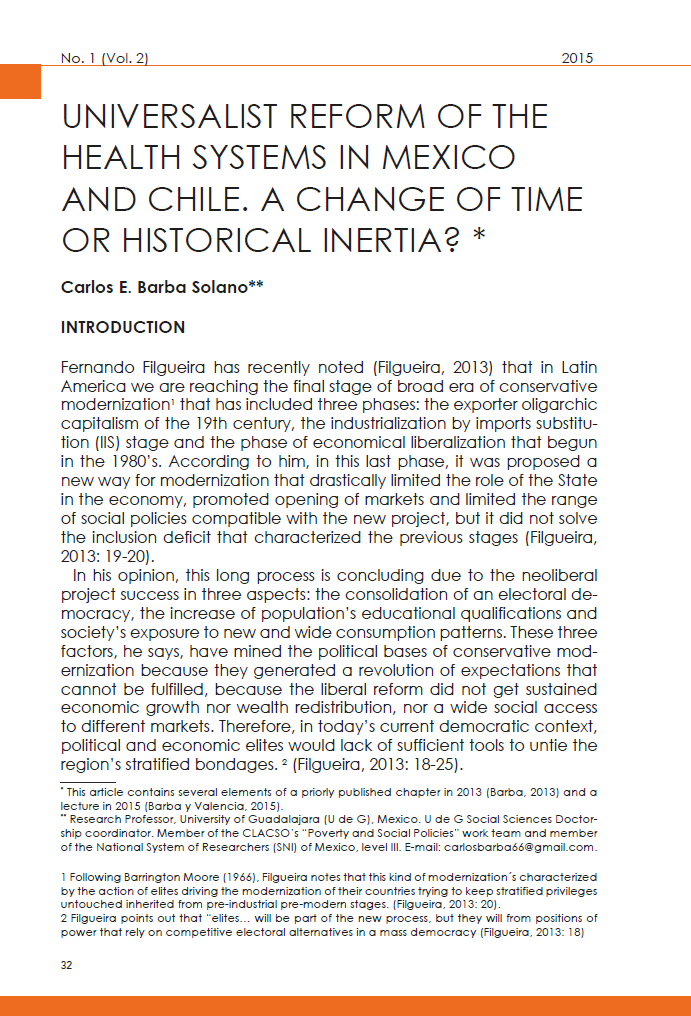UNIVERSALIST REFORM OF THE HEALTH SYSTEMS IN MEXICO AND CHILE. A CHANGE OF TIME OR HISTORICAL INERTIA?
Palabras clave:
Institutions, Public Policy, Social InequalityResumen
Fernando Filgueira has recently noted (Filgueira, 2013) that in LatinAmerica we are reaching the final stage of broad era of conservativemodernization1 that has included three phases: the exporter oligarchiccapitalism of the 19th century, the industrialization by imports substitution(IIS) stage and the phase of economical liberalization that begunin the 1980’s. According to him, in this last phase, it was proposed anew way for modernization that drastically limited the role of the Statein the economy, promoted opening of markets and limited the rangeof social policies compatible with the new project, but it did not solvethe inclusion deficit that characterized the previous stages (Filgueira,2013: 19-20).In his opinion, this long process is concluding due to the neoliberalproject success in three aspects: the consolidation of an electoral democracy,the increase of population’s educational qualifications andsociety’s exposure to new and wide consumption patterns. These threefactors, he says, have mined the political bases of conservative modernizationbecause they generated a revolution of expectations thatcannot be fulfilled, because the liberal reform did not get sustainedeconomic growth nor wealth redistribution, nor a wide social accessto different markets. Therefore, in today’s current democratic context,political and economic elites would lack of sufficient tools to untie theregion’s stratified bondages. 2 (Filgueira, 2013: 18-25).As a corollary of this thesis, Filgueira assures that “aturn to the left” has been produced in our region,that in the social scope is expressed as a change inthe orientation of its social policies and in the citizenshipconception. All of it as a consequence of theextension of the State’s fiscal capacities, the establishmentof wide programs of conditioned cash transfers(CCTs), the appearance of care policies aimedat reducing gender inequalities and a solidary turnof insurance schemes in the fields of pensions andhealth3 (Filgueira, 2013: 30-38).In the scope of social policies, particularly in thefield of health services we are interested in, the axisof this transformation in Latin America would be theemergence of a basic universalism in different versions4,that could crystallize into a universal benefitsand basic transfers system, combined with an additionalnon-contributory pillar and/or a private assuranceto access goods and non-essential services (Filgueira,2013: 39-40).With no doubt, Filgueira’s proposal is highly controversialbut serves in heuristic terms to analyze whatis happening in different types of social protectionsystems in Latin America. In the specific case thatconcerns us here, our interest is to analyze the scopeand limitations of reforms to health systems of Chileand Mexico, which could be framed on the aforementioned‘epochal change’ hypothesis or couldcontradict it. The specific interest covered by thesereforms is that both assume as a purpose to universalizesome segments of the public health services inboth countries.To achieve this objective, the first segment of this articlewill examine traditional patterns of health systemsin the region. The second will review the type of healthsystems prevailing in Latin America. The third will examinethe general characteristics of health reforms inLatin America, political contexts and the main actorsin the reforms. The fourth will review the three reformistwaves that have been developing since the eighties.The fifth will analyze the health reforms in Chile andMexico. We will conclude with a final reflection onthe strength of the previously mentioned hypothesisbrought to the light of the two reforms.
Descargas
Publicado
Cómo citar
Número
Sección
Licencia

Esta obra está bajo una licencia internacional Creative Commons Atribución-NoComercial-CompartirIgual 4.0.




